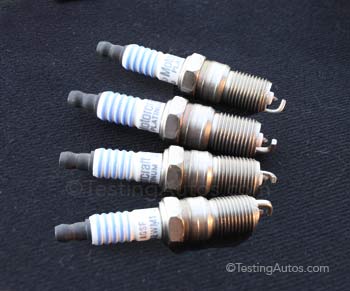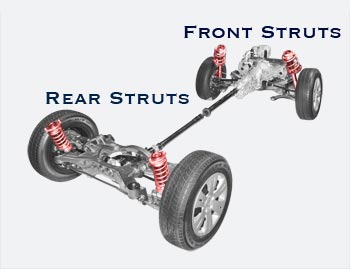Home > Car Care > When Does the Timing Belt Need to be Replaced?
When Does the Timing Belt Need to be Replaced?
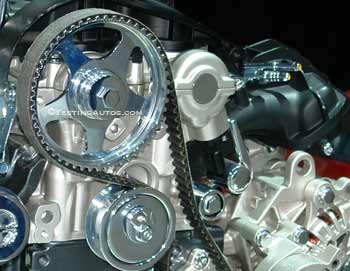
Timing belt.
The timing belt, a critical component in the engine, precisely synchronizes the movement of pistons and valve openings. Over time, it wears out, and if it breaks, the engine may stall, leading to potential costly repairs. Knowing why and when to replace it is vital for preventing such issues. See
timing belt diagram.
1. Recommended Replacement Intervals:
For most cars, timing belt replacement intervals typically range between 60,000 and 106,000 miles, with some modern vehicles extending this duration. Manufacturers may also include time intervals, such as every 7 years, in their recommendations. To determine your specific replacement schedule, consult your car's maintenance schedule in the owner's manual or a separate Warranty and Maintenance brochure.
2. Signs of a Stretched Timing Belt:
Identifying warning signs is crucial for proactive maintenance. Symptoms include:
- Difficulty starting the vehicle.
- Unusual noises such as rattling, that originate from the timing belt area.
- Engine misfiring, sluggishness.
- Illumination of the Check Engine light with codes related to timing (i.e. P0341).
These indicators necessitate a prompt inspection of the timing belt. Often, however, a worn-out timing belt shows no symptoms and can only be identified during a visual inspection.
3. Visual Inspection and Diagnostic Details:
Mechanics can visually inspect the timing belt by removing one of the covers. If signs of wear or stretching are detected, it's essential to address the issue promptly to avoid further complications. See also:
photo of a badly worn timing belt.
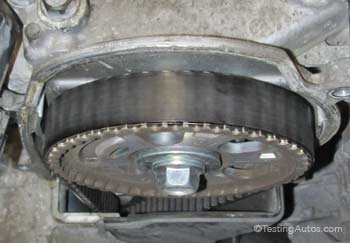
1. This timing belt is in good condition.
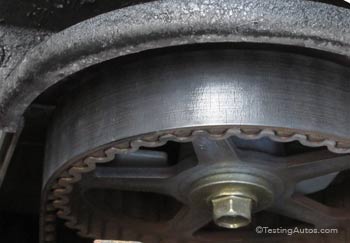
2. This belt looks cracked and worn out.
4. Consequences of Timing Belt Failure:
Differentiating between interference and non-interference engines is crucial. In an interference engine, a broken timing belt during driving may lead to severe engine damage, while a non-interference engine may stall with limited damage. Read more and see the animations:
Interference versus Non-Interference engine animation.
5. Timing Belt Replacement Cost and Additional Components:
Timing belt replacement costs vary, ranging from $250 to $1,000 or more, depending on the engine type and additional parts like a water pump. While not mandatory, replacing the water pump and related hardware during timing belt replacement is often recommended to improve longevity and minimize future maintenance.
6. Identifying Engine Type and Checking Maintenance Schedule:
Many cars offer several engine options. Determining your car's engine size is crucial for understanding its maintenance needs. Methods include decoding the VIN number online or checking the Vehicle Emissions Label under the hood. Once the engine size is known, check the owner's manual or an online maintenance schedule.
7. DIY Considerations:
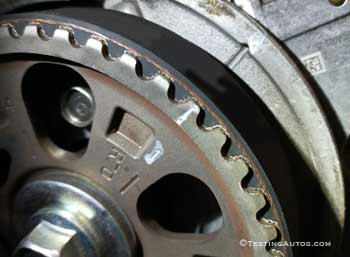
Timing mark in the Honda V6 engine.
For those with technical skills and the necessary tools, replacing a timing belt as a DIY project is feasible. However, the complexity varies between cars. Smaller, 4-cylinder engines may be more straightforward, while larger V6 engines may pose challenges, such as tight spaces and specialized tools for tasks like removing the harmonic balancer. Setting the timing correctly is vital. Some engines have timing marks, while others don't. Check the service manual or watch the How-to video on Youtube.
8. Does my Car Have a Timing Belt or Chain?
Many modern cars have a
timing chain instead of the timing belt. To verify whether your car has a belt or chain, check your maintenance schedule or ask your dealer or a mechanic. Toyota, for example, published the list of models that have a timing belt online:
Does my vehicle have a timing belt or timing chain?. You can also simply google it mentioning the Make Year Model and the Engine Size of your car.




